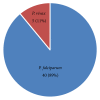Visceral Leishmaniasis-Malaria Coinfection and Their Associated Factors in Patients Attending Metema Hospital, Northwest Ethiopia: Suggestion for Integrated Vector Management
- PMID: 28932617
- PMCID: PMC5592390
- DOI: 10.1155/2017/6816913
Visceral Leishmaniasis-Malaria Coinfection and Their Associated Factors in Patients Attending Metema Hospital, Northwest Ethiopia: Suggestion for Integrated Vector Management
Abstract
Background: Despite high prevalence of visceral leishmaniasis and malaria in the study area, their coinfection remains unknown. Therefore, this study was aimed to document VL-malaria coinfections and their associated factors.
Methods: A cross-sectional study was conducted among clinical suspected VL patients attending Metema hospital, Northwest Ethiopia, from January 2014 to June 2014. Blood sample was tested by rk39 antigen-based DiaMed IT-Leish dipstick and Giemsa stain microscopic examination of thick and thin blood smears for malaria detection was performed.
Result: A total of 384 VL suspected patients were included in the study. Out of these, the prevalence of VL was 83 (21.6%) while the prevalence of malaria was 45 (11.7%). Of malaria cases, 40 (89%) were positive for P. falciparum and 5 (11%) positive for P. vivax. The overall prevalence of VL-malaria coinfection was 16 (4.2%). One-hundred eighty (46.9%) study participants have history of travel. Of these, 10 (5.6%) have VL-malaria coinfections. Age less than 5 years was associated with VL-malaria coinfection.
Conclusion: This study highlights the importance of performing malaria screening amongst VL patients living in malaria-endemic areas, particularly in patients under five years.
Figures
Similar articles
-
Detection of asymptomatic Leishmania infection in blood donors at two blood banks in Ethiopia.PLoS Negl Trop Dis. 2023 Mar 9;17(3):e0011142. doi: 10.1371/journal.pntd.0011142. eCollection 2023 Mar. PLoS Negl Trop Dis. 2023. PMID: 36893183 Free PMC article.
-
Sero-Prevalence of Visceral Leishmaniasis and Associated Risk Factors among Febrile Patients Attending Metema Hospital, West Gondar Zone, North West Ethiopia.Acta Parasitol. 2024 Sep;69(3):1621-1629. doi: 10.1007/s11686-024-00882-3. Epub 2024 Aug 20. Acta Parasitol. 2024. PMID: 39162925
-
Asymptomatic Leishmania donovani infection and associated factors among blood donors attending at Metema district Blood Bank, Northwest Ethiopia: a cross- sectional study.Arch Public Health. 2023 Apr 21;81(1):62. doi: 10.1186/s13690-023-01082-7. Arch Public Health. 2023. PMID: 37085820 Free PMC article.
-
Prevalence estimates of human immunodeficiency virus (HIV) infection among visceral leishmaniasis infected people in Northwest Ethiopia: a systematic review and meta-analysis.BMC Infect Dis. 2020 Mar 12;20(1):214. doi: 10.1186/s12879-020-4935-x. BMC Infect Dis. 2020. PMID: 32164607 Free PMC article.
-
Prevalence and characteristics of malaria co-infection among individuals with visceral leishmaniasis in Africa and Asia: a systematic review and meta-analysis.Parasit Vectors. 2021 Oct 23;14(1):545. doi: 10.1186/s13071-021-05045-1. Parasit Vectors. 2021. PMID: 34688312 Free PMC article.
Cited by
-
Cutaneous leishmaniasis a neglected tropical disease: community knowledge, attitude and practices in an endemic area, Northwest Ethiopia.BMC Infect Dis. 2019 Oct 16;19(1):855. doi: 10.1186/s12879-019-4506-1. BMC Infect Dis. 2019. PMID: 31619180 Free PMC article.
-
Cutaneous Manifestations of Malaria and Their Prognostic Windows: A Narrative Review.Cureus. 2023 Jul 11;15(7):e41706. doi: 10.7759/cureus.41706. eCollection 2023 Jul. Cureus. 2023. PMID: 37575836 Free PMC article. Review.
-
Level of circulating steroid hormones in malaria and cutaneous leishmaniasis: a case control study.J Parasit Dis. 2019 Mar;43(1):54-58. doi: 10.1007/s12639-018-1055-2. Epub 2018 Nov 20. J Parasit Dis. 2019. PMID: 30956446 Free PMC article.
-
Unusual Observations in Leishmaniasis-An Overview.Pathogens. 2023 Feb 10;12(2):297. doi: 10.3390/pathogens12020297. Pathogens. 2023. PMID: 36839569 Free PMC article. Review.
-
Matching Development of Point-of-Care Diagnostic Tests to the Local Context: A Case Study of Visceral Leishmaniasis in Kenya and Uganda.Glob Health Sci Pract. 2020 Sep 30;8(3):549-565. doi: 10.9745/GHSP-D-20-00028. Print 2020 Sep 30. Glob Health Sci Pract. 2020. PMID: 33008863 Free PMC article.
References
-
- Snow R., Craig M., Newton C., Stekete R. The Public Health Burden of Plasmodium Falciparum Malaria in Africa: Deriving the Numbers. Bethesda, MD, USA: Forgarty International Center, National Institute of Health; 2003.
-
- World Health Organization. World Malaria Report 2016. http://apps.who.int/iris/bitstream/10665/252038/1/9789241511711-eng.pdf.
-
- Lukeš J., Mauricio I. L., Schönian G., et al. Evolutionary and geographical history of the Leishmania donovani complex with a revision of current taxonomy. Proceedings of the National Academy of Sciences of the United States of America. 2007;104(22):9375–9380. doi: 10.1073/pnas.0703678104. - DOI - PMC - PubMed
LinkOut - more resources
Full Text Sources
Other Literature Sources


